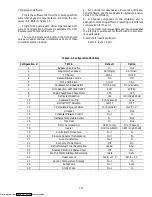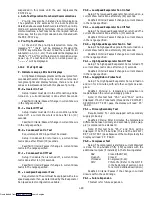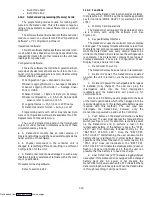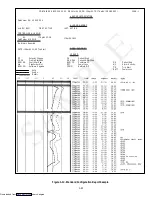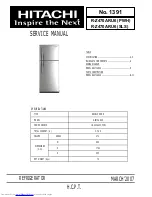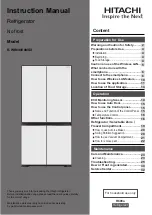
1-26
This alarm triggers the failure action code set by
Code Cd29.
Alarm 27 --- Probe Circuit System Calibration Failure
The controller has a built-in A/D (Analog to Digital)
converter, used to convert analog readings (i.e. tempera-
ture sensors, current sensors, etc.) to digital readings.
The controller continuously performs calibration tests on
the A/D converter. If the A/D converter fails to calibrate
for 30 consecutive seconds, this alarm is activated.
This alarm will be inactivated as soon as the A/D
converter calibrates.
Alarm 51 --- Alarm List Failure
During
start-up
diagnostics,
the
memory
(EEPROM) is examined to determine validity of its
contents. This is done by testing the set point and the
alarm list. If the contents are invalid, Alarm 51 is set.
During control processing, any operation involving
alarm list activity that results in an error will cause Alarm
51 to be set.
Alarm 51 is a “display only” alarm and is not written
into the alarm list. Pressing the ENTER key when clear is
displayed will result in an attempt to clear the alarm list. If
that action is successful (all alarms are inactive), Alarm
51 will be reset.
Alarm 52 --- Alarm List Full
Alarm 52 is set whenever the alarm list is determined
to be full; at start-up or after recording an alarm in the
list. Alarm 52 is displayed, but is not recorded in the alarm
list.
This alarm can be reset by clearing the alarm list. This
can be done only if all alarms written in the list are
inactive.
Alarm 53 --- Mains Voltage Sensor Failure
Alarm 53 is caused by three consecutive line voltage
readings of less than 30VAC. When AL53 is active, the
current limit settings and current draw tables will be
determined based on the most recent valid voltage
reading. The settings and tables will continue to be
determined in this manner until the sensor is determined
to be valid.
Alarm 54 --- Primary Supply Air Sensor Failure
Alarm 54 is set by an invalid primary supply sensor
reading, that is, outside the range of ---50 to +70
_
C
(---58
_
F to +158
_
F).
If Alarm 54 is set and the primary supply is the
control sensor, the secondary supply sensor will be used
for control if the unit is so equipped.
If the unit does not have a secondary supply probe,
and AL54 is set, the (primary return sensor, minus 2
_
C)
will be used for control.
Alarm 55 --- Secondary Supply Air Sensor Failure
Alarm 55 is set by an invalid secondary supply sensor
reading, that is, outside the range of ---50 to +70
_
C
(---58
_
F to +158
_
F).
If Alarm 55 is set and the secondary supply is the
control sensor, the the primary return sensor will be used
for control.
Alarm 56 --- Primary Return Air Sensor Failure
Alarm 56 is set by an invalid primary return sensor
reading, that is, outside the range of ---50 to +70
_
C
(---58
_
F to +158
_
F).
If Alarm 56 is set and the primary return is the
control sensor, the primary supply sensor will be used for
control.
Alarm 57 --- Ambient Temperature Sensor Failure
Alarm 57 is triggered by an ambient temperature
reading outside the valid range from ---50
_
C (---58
_
F) to
+70
_
C (+158
_
F). This is a display alarm and has no
associated failure action.
Alarm 58 --- Compressor High Pressure Safety
Alarm 58 is triggered when the compressor high
discharge pressure safety switch remains open for at least
one minute. This alarm will remain active until the
pressure switch resets, at which time the compressor will
restart.
Alarm 59 --- Heat Termination Thermostat (HTT)
Safety
Alarm 59 is triggered by the opening of the heat
termination thermostat and will result in the disabling of
the heater. This alarm will remain active until the
thermostat resets.
Alarm 60 --- Defrost Termination Sensor Failure
Alarm 60 is an indication of a probable failure of the
defrost termination sensor (DTS). It is triggered by the
opening of the heat termination thermostat (HTT) or the
failure of the DTS to go above 25.6
_
C (78
_
F) within 2
hours of defrost initiation.
After one-half hour with a frozen range set point, or
one-half hour of compressor run time, if the return air
falls below 7
_
C (45
_
F), the controller checks to ensure
defrost termination sensor (DTS) has dropped to 10
_
C
or below. If not, a DTS failure alarm is given and the
defrost mode is operated off of return temperature
sensor (RTS). The defrost mode will be terminated after
one hour by the controller.
Alarm 61 --- Heaters Failure
Alarm 61 is the heater alarm caused by detection of
improper amperage resulting from heater activation
(deactivation). Each phase of the power source is
checked for proper amperage.
This alarm is a display alarm with no resulting failure
action, and will be reset by a proper amp draw of the
heater.
Alarm 62 --- Compressor Circuit Failure
Alarm 62 is triggered by improper current draw
increase (decrease) resulting from compressor turn on
(off). The compressor is expected to draw a minimum of 2
amps; failure to do so will cause the alarm.
This is a display alarm with no associated failure
action and will be reset by a proper amp draw of the
compressor.
Downloaded from






